|
Florida has many famous bass lakes, but river fishing produces giants too as James Shubert's 14 lbs. 8 oz. Withlacoochee River catch attests.
TrophyCatch's peak annual quarter of fishing is producing some great catches, including the current Season 12 leader caught in the Withlacoochee River by James Shubert and weighing 14 lbs. 8 oz. (above). Nice fish from across the state continue to come in, and we hope your next catch might be among them. The current TrophyCatch numbers are below.
- 11,980 Lunker Club (8-9.9 lbs.)
- 3,018 Trophy Club (10-12.9 lbs.)
- 149 Hall of Fame (13+ lbs.)
- 15,147 TOTAL approved submissions to date
Register for TrophyCatch or view approved angler catches to help plan your next fishing trip at TrophyCatch.com. Follow TrophyCatch Facebook for featured big bass, program updates and partner highlights. For more news and freshwater information follow us on the FishReelFlorida Instagram.
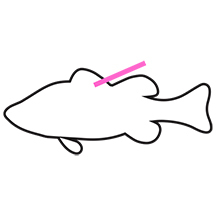
The big TrophyCatch news this quarter is the reintroduction of the Pink Tags! Specially tagged bass worth extra prizes can be found swimming in these five waterbodies:
- The Northwest Winter Haven Chain of Lakes
- Lochloosa Lake
- Lake Beauclair
- Lake Okeechobee
- Porter Lake
If you catch a pink-tagged bass, cut the tag and keep it. Be sure to photograph the entire bass on a scale with a readable weight per TrophyCatch instructions to qualify for prizes. The bass must be released alive. Then, submit your catch information at TrophyCatch.com for some great prizes. More details, site information, and rules can be found at the TrophyCatch Pink Tag Page.
|
Keep your eyes open for a pink tag (circled) on any bass from the Northwest Winter Haven Chain of Lakes, Lochloosa Lake, Lake Beauclair, Lake Okeechobee, or Porter Lake!
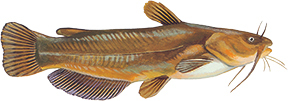
Size: The yellow bullhead state record is 5.05 pounds, but most catches will average closer to half of a pound. The Big Catch minimum qualifying sizes are 1.5 pounds or 14 inches for adults, and 1.0 lbs or 10 inches for youth (see BigCatchFlorida.com).
Appearance: This species is brownish above, and white to yellow below. The dorsal and pectoral fin spines and barbells make this fish easy to diagnose as a catfish. The tail is usually squared, but may be slightly forked. This fish is often called a “buttercat” due its coloration—though the name can be a cooking suggestion as well! The related but darker brown bullhead also occurs in Florida and is usually much darker, sometimes with distinct black-and-white mottling. The surest way to tell these two apart is to examine the chin (not mouth) barbells: those of the yellow bullhead will be entirely white or yellow, while those of the brown bullhead will range from darkly spotted, to entirely black.
Range & Habitat: While there aren't any locales particularly noted for yellow bullhead fishing, these small catfish occur in most Florida waters, from rivers and canals to lakes and ponds. Fishing bait on the bottom almost anywhere in the state might put a "buttercat" on the end of your line!
Sporting Quality: Spring or summer is a great time to sit back, soak a line, and do some catfishing! The yellow bullhead is a small catfish, but an important component of the catfish angler’s catch in some parts of Florida. Due to its diminutive size, light tackle is recommended. All popular catfish baits will attract this species, with favorites including various commercial catfish preparations, chicken livers, and red wigglers. The yellow bullhead’s preference for the latter often causes it to end up on the lines of bottom-fishing bream anglers. Handle bullheads with care to avoid a painful puncture from the dorsal or pectoral fin spines! This fish, like most other catfishes, can provide excellent table fare.
Fish illustration by Duane Raver, Jr.
|
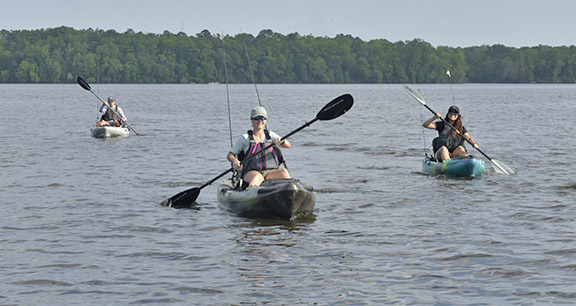 |
Small boats provide big adventure! Florida's 8,000 named lakes and 12,000 miles of rivers offer almost unlimited exploration for go-anywhere small crafts.
Last issue introduced the big advantage of small boats, including float tubes, inflatables, and kayaks. This issue wraps up with canoes and johnboats, and some general small boating advice.
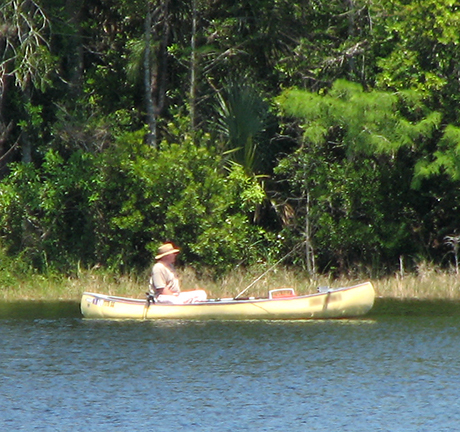
Canoes
Canoes, like kayaks, have also been around for thousands of years. Although your first meeting with a canoe may have been with an aluminum craft as a kid at summer camp, most modern offerings are fiberglass or polymer synthetics. This is a good thing—for sneaking up on fish, such craft are much quieter. Sizes usually range from 14’ to 16’+, and your choice should be determined by whether you expect to fish alone or with company. Canoes are heavier than kayaks, and a larger canoe will be a handful to get off and back onto the roof racks on days you go it alone. However, that extra weight compared to kayaks gets you a much wider and more stable craft with significant storage space, even in the smallest sizes. Many canoes incorporate a brace that doubles as a shoulder yoke (carrying brace), helpful for portaging between parking space and launch site. Accessories to consider include a seat back, especially if you spend long days on the water. Paddle choice is not as critical as with kayaks, and even an economical plastic-and-aluminum job will do for most folks. One possible option in this vessel class is a square stern, which allows the mounting of a small electric or gas outboard. Such a combo is extremely efficient. However, the square-stern canoes tend to be heavy enough to make them two-man (or trailer) craft when it comes to loading and launching. Canoes cost more on average than kayaks, with starting prices close to $400 and average cost running closer to $600 and up.
Photo: A canoe can be easily loaded with plenty of gear for a full and pleasant day on the water.
|
 Johnboats
Johnboats just make our list of craft that can be car-topped and hand-launched. By our 70-pound limit, 12’ will be the maximum size. Ten-footers are also available but will usually be one-man craft due to their smaller weight capacity. Johnboats, in their historical form as wooden punts and skiffs, are also old-timers in the boating world. Modern models are exclusively aluminum. The flat hull makes the most spacious and stable fishing platform available in the “small boat” world. However, it also makes the johnboat strictly a calm-water craft; it doesn’t take choppy water well. Most johnboat users will drop a small electric motor or gas outboard on the transom; just pay attention to the rated horsepower as many smaller johnboats are very limited in what they can handle. If you plan to row, row, row your boat, do yourself a favor and get the oarlocks that clamp right onto the oars. Pop-off swivel seats and an anchor are other accessories to consider. Expect to pay between $450 and $600 for a 10’ to 12’ johnboat and note that the cheaper editions will often be made of lighter gauge aluminum and therefore be easier to carry.
Photo: A johnboat is the classic Florida small craft.
The last word
Due to their reduced size, small watercraft are less stable than larger vessels. The FWC recommends always wearing a personal flotation device (PFD) on the water while in any vessel. Obviously, exercise common sense in which areas you access—don’t drop an inflatable into the busiest waters. And always watch for even moderately foul weather—small craft can’t handle it. Also, make sure you’re legally accessing the shoreline where you’re dropping in. Finally, small craft will take you places other anglers can’t go. So be polite to the homeowner not used to seeing someone off the end of their dock. Let them know how you got there if they ask, and tell them how much fun smaller watercraft can be. You might just find a “small boat” convert on your hands!
Newnans Lake offers 5,800 acres of scenic fishing.
Size: 5,800 acres
Location: Alachua County
Description: Newnans Lake is an FWC Fish Management Area located about two miles east of Gainesville on Highway 20. The lake is surrounded by cypress trees that provide good angling when water levels are high. Sparse areas of emergent grasses, bulrush, and spatterdock (water lilies) are found around the shoreline of Newnans Lake. The bulrush was planted by FWC in the late 1990s and early 2000s in order to enhance habitat. Excellent black crappie fishing is often the talk of the town, with Newnans Lake often being the top destination in the area for anglers looking to catch their limit. Largemouth bass are not quite as popular in Newnans, but there are some locals who know that quality bass fishing can be found on the lake if conditions are right. The most consistent fisheries on Newnans Lake are catfish and bream, and these can be caught year-round in deeper areas of the lake and the lake shoreline, respectively. There are some water quality challenges facing Newnans, primarily shallow, turbid water that limits light penetration and prevents the establishment of submersed aquatic vegetation and limits emergent plant growth. The result is that complex habitat is largely limited to the shoreline, with the exception being a large area of spatterdock offshore on the north end.

As in many lakes, water levels have been the driver of fisheries productivity in Newnans. The most recent example is when Hurricane Irma came through in 2017 and resulted in prolonged high water levels. As water levels rise, the surrounding cypress swamp is flooded, greatly expanding the habitat available to fish. The black crappie fishery responded well, with an excellent spawning event observed in 2018. The FWC has been conducting a research project that has shown when high numbers of “Age-0” crappie are observed during sampling (evidence of good spawning conditions earlier that year), that in 3-4 years anglers will be catching high numbers harvestable crappie. As forecast, crappie anglers had an excellent year in 2021. Anglers have also had an excellent year in 2024 so far, likely the “second generation” of the 2018 generation. As part of this research project, FWC has been tagging crappie in Newnans Lake since 2015 to determine what percentage of the population is being harvested each year. Anglers who report these tags receive a cash award, so keep an eye out!
|

FWC staff also made efforts to enhance the largemouth bass population into Newnans Lake. Since 2003, the FWC has stocked small numbers of bass over the years. Subsequent monitoring showed that a high proportion of bass collected originated from the hatchery, indicating that stocking was very successful. This led to a high-density stocking effort being conducted from 2019-2021, where almost 1 million fingerling bass were stocked. The results of this study are still being evaluated. To promote bass fishing on Newnans Lake, a trophy bass was tagged with a high value pink tag in 2022 as part of the TrophyCatch program’s 10-year anniversary celebration. Bass fishing effort doubled as a result of this promotion, and 8 trophy bass were reported to TrophyCatch in Season 10. There are some giant bass in Newnans Lake for those willing to find them!
|
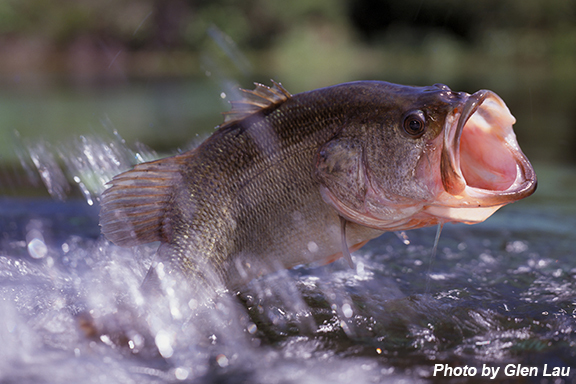 |
"He swims like a fish!" It's an expression you might have heard at the beach or during a swim meet. But how, exactly, do fish swim? Water is a much denser substance than air, and therefore much more difficult to move through. Fish must be hydrodynamically streamlined (think "aerodynamically," only underwater) in order to travel efficiently. For some species, speed is most important, while for others, maneuverability and turning ability are critical. In fact, you can tell a lot about how a fish moves—and how it makes a living—simply by the shape of its body.
First, how do fish swim at all? Basically, they undulate their bodies through the water in a snakelike motion. The undulations pass through the fish’s muscles in waves, and end with a brisk tail snap.
Fish swim by undulating through the water.
Forward motion is provided by both the pushing of the fish’s body against the water, and by the final tail snap. The water is actually pushed backward and—in accordance with Newton’s Third Law that for every action there is an equal and opposite reaction—the fish itself is thrust forward as this water is pushed off the fish’s body and tail. The rate at which these undulations pass through a fish’s muscles have a direct relationship to a fish’s speed. In some ways, this thrust is similar to that produced by the propeller on a boat motor.
A long, skinny fish such as a pickerel derives most of its forward motion from the muscle wave. Part of this is due to the fact that such a long fish can generate more waves in its body than a stubbier and thicker fish. Also note that a pickerel’s fins have a relatively small surface area compared with the length of the body, and the small caudal (tail) fin provides a correspondingly smaller amount of forward motion during the tail snap. On the other hand, a stockier species like the largemouth bass gets most of its speed from the tail snap of its large caudal fin, but not as much forward thrust from the muscle wave of its stubbier body. As the illustration below shows, a bass can’t generate as many waves in its shorter and stiffer body as a long supple pickerel can. For nearly all fish, though, both are important in providing thrust.
A long, supple pickerel (top) can produce more muscle waves along its body than a short, stocky bass (bottom).
What can we learn about how a fish lives by how it swims? Once again, let’s compare the pickerel and the bass. The pickerel’s long streamlined body is designed for speed. Its small fins tend to be farther back on its body, increasing its hydrodynamic efficiency and allowing it to “knife” through the water more easily. The pickerel can therefore be assumed to be a high-speed feeder, able to run down and capture its prey. You can also assume that if this is true, then the pickerel must feed on fast-moving prey organisms such as fish as opposed to slower foods such as crayfish. And this is exactly the case.
The largemouth bass, on the other hand, is stockier in build and probably only able to achieve high speeds briefly and over short distances. Thus, a largemouth is an ambush feeder, surprising and capturing its prey from a relatively short range. The comparatively larger size of its fins, as well as their placement closer to the center of the body, also indicate that for a bass, maneuverability is more important than velocity. Rather than running down prey over distance, the bass should be able to turn and maneuver sharply enough to capture its food almost immediately once it gets close to it. In addition, rather than concentrating its diet strictly on fast-moving prey, the bass is more likely to be a generalist predator, eating a broader range of prey species than the pickerel (able to capture fish when the opportunity arises, but also consuming such prey as crayfish and frogs). Again, this proves to be the case.
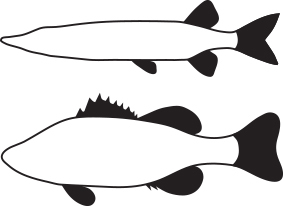 |
Note the differences in body shape and size, and the position of the fins between a pickerel and a bass.
How fast can fish swim? As one can imagine, clocking fish underwater is not easy! However, bass have been measured traveling at about 12 miles per hour (mph), and salmon slightly faster at 14 mph. The real speed records, however, go to saltwater fish. The barracuda—very similar in shape and feeding strategy to the pickerel—can move at about 28 mph. By far the fastest fish are the open ocean species. Bonitos and marlin have been estimated to reach 40 mph, while speeds of up to 60 mph (!) have been attributed to swordfish and tunas.
To contact the Florida Freshwater Angler, email John Cimbaro. Fish illustrations by Duane Raver, Jr. and Diane Rome Peebles. Bass photo by Glen Lau.
|